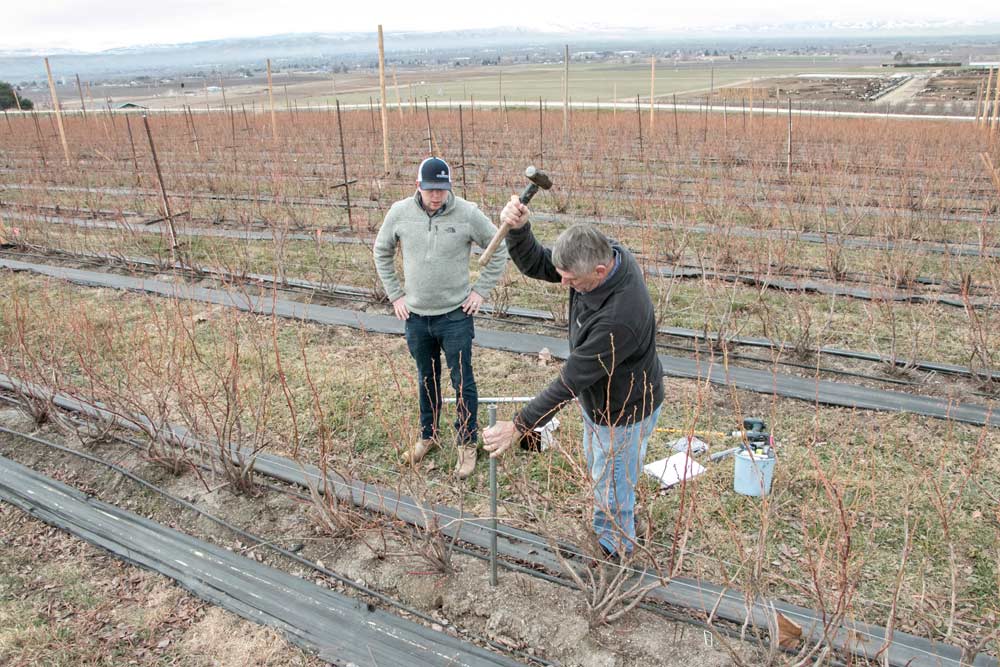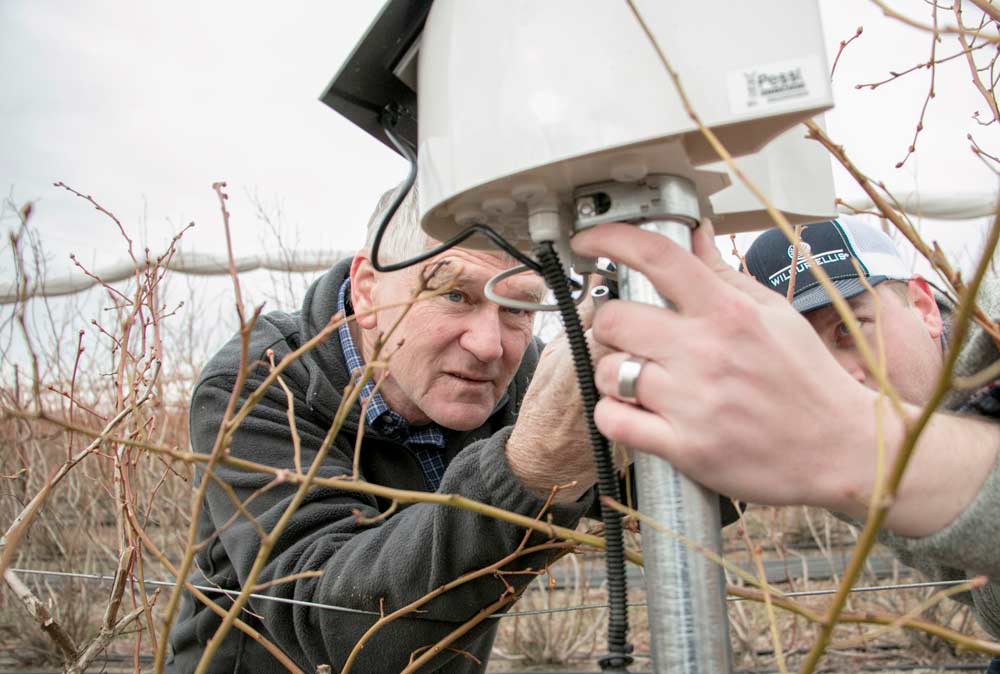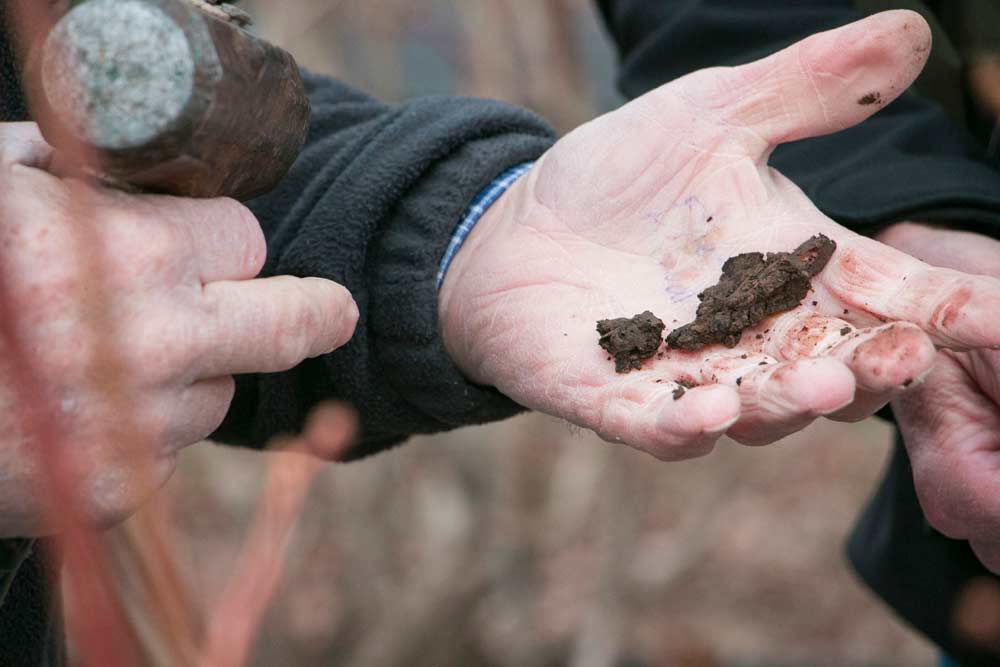
Irrigation consultant Jac Le Roux pounds a metal pipe for a guide hole as he prepares to install a soil moisture probe and telemetry equipment with Benjamin Sullivan, a Wilbur-Ellis irrigation technical support agronomist, Tuesday, Feb. 27, 2018, in a blueberry field in Zillah, Washington. Le Roux and irrigation specialists advocate irrigating tree fruit frequently, sometimes more than once a day, based on how much water plants use, as opposed to the traditional method of replenishing a large volume soil every week or so. (Ross Courtney/Good Fruit Grower)
After a few minutes of hammering and drilling, Jac Le Roux has a thin, 24-inch hole, deep enough for a soil moisture probe in a Zillah, Washington, blueberry patch.
He inserted the white tube so the top is flush with the ground and connected wiring to a nearby telemetry box about the size of a birdhouse.
The probe will measure how much water the plants use. The telemetry box will send that information to a database accessed with a smartphone, which he will use to schedule irrigation.
“It can’t be any easier,” said Le Roux, a soil moisture specialist in The Dalles, Oregon.

Irrigation consultant Jac Le Roux, left, and Benjamin Sullivan, a Wilbur-Ellis irrigation technical support agronomist, connect the wiring for soil moisture telemetry equipment Tuesday, Feb. 27, 2018, in a blueberry field in Zillah, Washington. (Ross Courtney/Good Fruit Grower)
As soil moisture and evapotranspiration monitoring technology becomes cheaper and more user-friendly, more growers are shifting their thinking about irrigation to line up with the shallower roots and higher densities of modern tree fruit orchards. No longer do experts like Le Roux suggest watering deep and infrequently to stretch the roots and fill a vast soil reservoir. Instead, they advise basing irrigation schedules on what a plant uses, even if it means watering more than once a day.
“The trick is never to over irrigate, rather go with several short instances,” Le Roux told a group of cherry growers in May at a field tour in The Dalles, where soil is sandy and often sits atop a layer of basalt that could cause puddles and drown trees if overwatered.
The ideas are not new, but soil moisture monitoring used to involve walking rows, checking probes and manually logging the readings, then trying to decipher archaic spreadsheets. Those days are over, Le Roux said.
“None of it is rocket science,” Le Roux said. “I think what is new is the technology has become easier.” Le Roux sells one of many software platforms to help growers schedule irrigation based on soil monitoring.
Watering changes
Most growers by now have converted from impact sprinklers that ran every week or 10 days to microsprinklers or drip irrigation, said Lynn Long, part-time research extension horticulture specialist for Oregon State University in The Dalles. However, too many still irrigate the old way, he said.
“It’s something that growers need to start thinking about,” Long said.

Irrigation consultant Jac Le Roux samples soil two-below the surface while installing a soil moisture probe and telemetry equipment Tuesday, Feb. 27, 2018, in a blueberry field in Zillah, Washington. (Ross Courtney/Good Fruit Grower)
A 2010 sweet cherry research project in British Columbia came up with the same lesson.
Researchers Denise and Gerry Nielsen found watering four times a day promoted better tree growth than once every other day, even though they applied the same volume of water overall in a four-year trial at Agriculture and Agri-Food Canada in Summerland.
“I think the reason the moisture content was higher under pulse irrigation was because irrigating every second day with a larger quantity of water meant some of the single-time water application passed below the root zone and was unavailable to the young tree roots,” said Gerry Neilsen.
The experiment dealt specifically with young trees, though they continued some of the treatments through years six and seven and the increase in vigor and health seemed to hold, he said.
Their work goes back even further to the late 1980s when the Canadian tree fruit industry encouraged growers to plant new apple cultivars in high densities, usually on dwarfing Malling 9 rootstocks, and all but required the use of drip irrigation, Denise Neilsen said.
The results favored scheduling based on evapotranspiration, the rate a plant consumes water, over soil measurements.
However, growers still wanted to schedule the same way as they did with broad-shooting sprinklers, watering once a week nice and deep. “It makes no sense to be watering huge volumes of soil,” she said.
Gradually, growers are coming around today, she said, echoing Le Roux’s theory that advancements in technology make it easier.
“The answers are there,” Denise said. “It’s a matter of adoption.”

Irrigation consultant Jac Le Roux augers a hole for a soil moisture probe Tuesday, Feb. 27, 2018, in a blueberry field in Zillah, Washington. (Ross Courtney/Good Fruit Grower)
Where it’s already wet
In the rainy Northeast, with high water tables and dense soil, fruit growers are still getting used to the idea of using irrigation at all, though most researchers from Cornell University and Michigan State University advise it.
Providing 1 inch a week is a good guideline for high-density apple trees, said Liz Madison, lead designer for Empire Drip Supply, a supply and service business in Sodus, New York, near Lake Ontario. She may suggest doubling that at planting time and in the heat of July.
Growers in the East can get away with infrequent watering due to their dense, loamy soil, compared to the sieve-like sand in the Northwest, she said. Thus, many of her growers don’t bother with measuring evapotranspiration and take a “set it and forget it” approach to scheduling water, she said.
“I have even fewer customers interested in taking advantage of new ‘smart’ controller technologies that have various types of sensors that help you by making the adjustments automatically based on the exact ET rate for that particular day,” she said.
That’s what Le Roux suggests in the Pacific Northwest. Though in-ground probes measure the moisture content of soil, they send reports as often as the grower would like — every 30 minutes even — to allow reacting to evapotranspiration like the Neilsens suggest, he said.
“We’re responding to the plant’s use of water,” he said. “So as the plant takes away water, we can see how much has been taken, or we can calculate it, and we want to put back at least that equivalent.” •
—by Ross Courtney






Leave A Comment